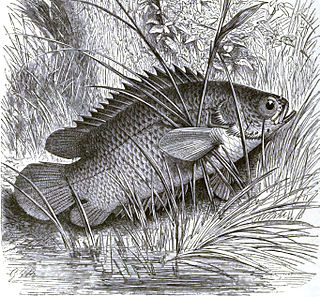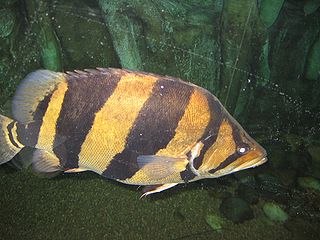
The Anabantidae are a family of ray-finned fish within the order Anabantiformes commonly called the climbing gouramies or climbing perches. The family includes about 34 species. As labyrinth fishes, they possess a labyrinth organ, a structure in the fish's head which allows it to breathe atmospheric oxygen. Fish of this family are commonly seen gulping at air at the surface of the water. The air is held in a structure called the suprabranchial chamber, where oxygen diffuses into the bloodstream via the respiratory epithelium covering the labyrinth organ. This therefore allows the fish to move small distances across land.

The Asian small-clawed otter, also known as the oriental small-clawed otter and the small-clawed otter, is an otter species native to South and Southeast Asia. It has short claws that do not extend beyond the pads of its webbed digits. With a total body length of 730 to 960 mm, and a maximum weight of 3.5 kg (7.7 lb), it is the smallest otter species.

The yellow perch, commonly referred to as perch, striped perch, American perch or preacher is a freshwater perciform fish native to much of North America. The yellow perch was described in 1814 by Samuel Latham Mitchill from New York. It is closely related, and morphologically similar to the European perch ; and is sometimes considered a subspecies of its European counterpart.
Salangidae, the icefishes or noodlefishes, are a family of small osmeriform fish, related to the smelts. They are found in Eastern Asia, ranging from the Russian Far East in the north to Vietnam in the south, with the highest species richness in China. Some species are widespread and common, but others have relatively small ranges and are threatened. Depending on species, they inhabit coastal marine, brackish or fresh water habitats, and some are anadromous, only visiting fresh water to spawn.

The lesser fish eagle is a species of Icthyophaga found in the Indian subcontinent, primarily in the foothills of the Himalayas, and south-east Asia. There are records from Gujarat, Central India and in more recent times from the Kaveri river valley in southern India, although the south Indian records are now thought to come from an isolated population, disjunct from the species' normal range. Some taxonomic authorities place this species in the monotypic genus Icthyophaga. Others place it in the genus Haliaeetus.

The European perch, also known as the common perch, redfin perch, big-scaled redfin, English perch, Euro perch, Eurasian perch, Eurasian river perch, Hatch, poor man's rockfish or in Anglophone parts of Europe, simply the perch, is a predatory freshwater fish native to Europe and North Asia. It is the type species of the genus Perca.

The crested kingfisher is a very large kingfisher that is native to parts of southern Asia. It is part of the kingfisher genus (Megaceryle) with three other species: the giant kingfisher, the ringed kingfisher, and the belted kingfisher with which it forms a species complex.
Climbing perch may refer to:

The climbing perch is a species of amphibious freshwater fish in the family Anabantidae. A labyrinth fish native to Far Eastern Asia, the fish inhabits freshwater systems from Pakistan, India, Bangladesh and Sri Lanka in the west, to Southern China in the east, and to Southeast Asia west of the Wallace Line in the south. It is likely that Anabas testudineus is a species complex, with the binomial name applied to what are actually several different species. With further study, populations of this fish may be divided up into separate species and given new names. In Nepalese Terai it is called "Pothiya". In Bengali it is called "দেশি কৈ". In maithili spoken in Bihar it is called Kabai.In Indonesia, it is known by many names, such as betok (Indonesian), běthik (Javanese), and papuyu (Banjarese)

Lake Buhi is a lake found in Buhi, Camarines Sur in the Philippines. It has an area of 18 square kilometres and has an average depth of 8 metres (26 ft). The lake lies in the valley formed by two ancient volcanoes, Mount Iriga and Mount Malinao. It was created in 1641, when an earthquake caused a side of Mount Asog to collapse. The resulting landslide created a natural dam that blocked the flow of nearby streams. Another theory suggests that it was created by the eruption of Mt. Asog, which is now dormant.

Microctenopoma ansorgii is a small freshwater fish, known in the aquarium trade as the ornate ctenopoma, orange ctenopoma, ornate climbing perch, pretty ctenopoma, or rainbow ctenopoma. It is related to the more familiar spotted climbing perch, but looks very different. Its body is more elongated and rounded, with fins with red and black stripes; the color intensifies when the fish are displaying, with black bars becoming visible on the body. The ornate ctenopoma spawns at night, laying its eggs on a floating bubble nest like its relatives in the osphronemidae. It lives in the slow-flowing forest streams of the Congo Basin, where it feeds on worms, insect larvae, and other aquatic invertebrates. It is the most common member of its genus in the aquarium trade, where it is known for being a shy, easily bullied fish that needs live or frozen foods and which benefits from the presence of smaller dither fish to encourage it to come out of hiding.

Gymnocephalus is a genus of ray-finned fishes from the family Percidae, which includes the perches, pike-perches and darters. They are from the Western Palearctic area, although one species, Gymnocephalus cernua has been accidentally introduced to the Great Lakes region where it is regarded as an invasive species. They have the common name "ruffe" and resemble the true perches in the genus Perca, but are usually smaller and have a different pattern.

The Asian swamp eel, also known as rice eel, ricefield eel, rice paddy eel or white rice-field eel, is a commercially important air-breathing species of fish in the family Synbranchidae. It occurs in East and Southeast Asia, where it is commonly sold and eaten throughout the region. It has been introduced to two areas near the Everglades in Florida and near Atlanta in Georgia.

The Siamese tigerfish, also known as the Siamese tiger perch, is a species of ray-finned fish belonging to the family Lobotidae, the tripletails and tiger perches. This fish is endemic to Indochina and is assessed as Critically Endangered by the IUCN.

Datnioides is a genus of ray-finned fish belonging to the family Lobotidae. These fishes are commonly known as tigerfish, tiger perch or freshwater tripletails. These fishes are found in the rivers of southern Asia and new Guinea.

Datnioides undecimradiatus, the Mekong tiger perch is a species of freshwater fish belonging to the family Lobotidae, the triplefins and tiger perches. This species is endemic to the lower and middle Mekong basin in Indochina.

Datnioides polota, the silver tigerfish, silver tiger perch, barred tigerfish, four-banded tripletail, four-banded tigerfish or four-barred tigerfish, is a species of ray-finned fish belonging to the family Lobotidae, the tripletails and tiger perches. This fish is found in southern Asia and New Guinea.

The Anabantiformes, is an order of bony fish (Teleostei) proposed in 2009. They are collectively known as labyrinth fish, are an order of air-breathing freshwater ray-finned fish with two suborders, five families and at least 207 species. In addition, some authorities expand the order to include the suborder Nandoidei, which includes three families - the Nandidae, Badidae and Pristolepididae - that appear to be closely related to the Anabantiformes. The order, and these three related families, are part of a monophyletic clade which is a sister clade to the Ovalentaria, the other orders in the clade being Synbranchiformes, Carangiformes, Istiophoriformes and Pleuronectiformes. This clade is sometimes referred to as the Carangaria but is left unnamed and unranked in Fishes of the World. This group of fish are found in Asia and Africa, with some species introduced in United States of America.
Hail Haor Wildlife Sanctuary is a major wildlife sanctuary in Bangladesh. It is one of the most important wetlands in the Sylhet Basin for the resident and migratory waterfowls. It is also important watersource for the inhabitants living around when all other sources dry up during summer. The sanctuary is located in Moulvibazar District, in the northeast region of the country.
Dagobert Carlvon Daldorff was a senior lieutenant in the Danish East India Company, naturalist and collector of natural history specimens. He is commemorated in the crab genus Daldorfia.
















